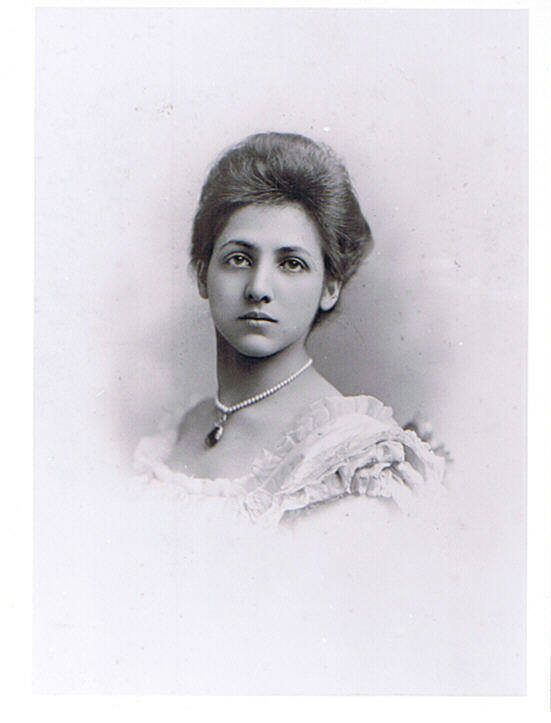Princess Catherine Duleep Singh

The Maharajah’s second daughter was born on the 27 October 1871, and was named Catherine Hilda Duleep Singh. On her family’s return from Aden without her father and the subsequent death of her mother, Princess Catherine and her sisters were moved to Folkestone, at 21 Clifton Street in the care of Arthur Oliphant. The Queen had originally desired Lady Login to take an interest in the charge of the three Princesses, but the India Office decided that the Princesses and the youngest boy Prince Albert Edward should be placed in the charge of Mr Oliphant, whose father James had been the Maharajah’s equerry.
It was under the care of the Mr and Mrs Oliphant, that Princess Catherine would meet her governess, a certain Miss Fraulein ‘Lina’ Schafer, who was twelve years Princess Catherine’s senior. The German governess from Kassel would become the Princess’s life long confidante and would change her life forever. In addition to the governess, violin and singing tutors were also employed, together with a swimming instructor. The following year Lina Schafer took the Princess to the ‘Black Forest’ in Kassel and Dresden. The odd-pair were forming a very special and intimate bond.
In 1903 Princess Catherine embarked on a tour of India, visiting Lahore, Kashmir, Dalhousie, Simla, and the holy Sikh city of Amritsar.[i] Here she recalled meeting old Sikh elderlies at the ongoing Diwali festivities who had fought under her grandfather, Maharajah Ranjit Singh. ‘The Diwali festival was yesterday; there were illuminations at the Golden Temple and at the Tank.[ii] The fireworks were let off from one side of the tank, the effect of the reflections in the water were very pretty.’[iii] She surprisingly knew much about her ancestral past and took much interest in it, ‘I visited the salt range, at Pind Dadun Khan,’ these were the very ones Maharajah Duleep Singh had talked about recovering from the Government in 1885, as he claimed they were his personal ancestral property. ‘There remains a strong fortress in a gateway built by Maha [sic] Singh, which was most interesting’.[iv] On her passage towards the Khyber Pass, she added, ‘Before the gates to the pass is the Fort of Jamrud, where Hari Singh[v] was, and where he died fighting.’ In February 1904 she visited the Sikh princely states of Kapurthala, Nabha, Jind and Patiala, ‘We met the Rajas in each case except Patiala, but we met the late Maharaja’s brother and President at dinner.’ She left India at the end of March 1904.
The Princess spent most of her life in Europe, shared between her family in Switzerland and the company of Lina Schafer in Kassel. Lina died on the 27 August 1937 at the age of 78 and Princess Catherine was much aggrieved by her death. In Germany, Nazism was on the increase, and war was just around the corner. The local Nazis disapproved of the old Indian lady. She now felt that Kassel had nothing to offer her, especially as Lina had departed. Her neighbour and accountant Dr Fritz Ratig warned her to leave the country. In November 1937 Princess Catherine sold everything and fled, arriving back in England via Switzerland.
Deep into the Second World War, with Nazi occupation spreading rapidly across Europe, Princess Catherine passed away peacefully in her bed on the night of Sunday 8 November 1942 at her home in Penn, aged seventy-one.[vi] The cause of death was said to be heart failure.[vii] It was her wish to be cremated and ‘Frank Perfect & Sons’ funeral directors had the responsibility for the delicate arrangements. On the 12 November her beautifully reefed coffin was placed at Coalhatch House so all her servants and friends could pay their last respects before the cortege was borne from Penn to Golders Green crematorium in North London.[viii]
[i] Other places visited were Peshawer, Rawalpindi, Indus, Kabul, Multan,
[ii] The Tank or Sarovar is the large body of water around the Golden Temple in Amritsar
[iii] British Library, India Office Section, Letter from Princess Catherine to Princess Sophia, dated 20 October 1903, f. MSS E377/4
[iv] British Library, India Office Section, Letter from Princess Sophia to Princess Catherine, f. Mss E377/4
[v] Hari Singh Nalwa was the bravest of Ranjit Singh’s Generals, who died at Jamrod
[vi] Shirley Phimister, (1999)
[vii] Sandhawalia family papers, Letter to Pritam Singh from Karim Baksh, dated 18 November 1942
[viii] Golders Green Crematorium, Register No. 55310.